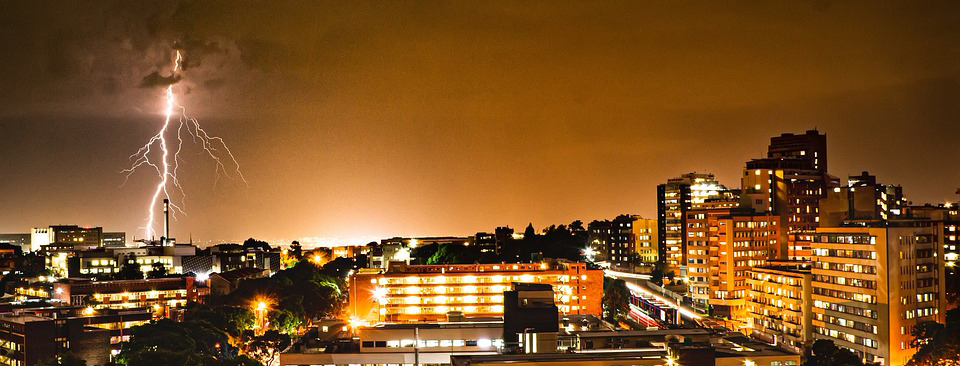Power surge
A power surge is when an unusually high voltage occurs in an electrical system for a short period. It may also be referred to as a transient surge because it involves a transient wave of voltage, current or power which usually occurs between the normal waves of voltage. The over voltage can be additive or subtractive with positive or negative polarity lasting less than a half-cycle, or at little as 50 microseconds but surges can reach 6000 Volts and 3000Amps which can cause damage.
Power surges often occur after power cuts or blackouts as systems are reinstalled or turned on again. Lightening strikes can cause power cuts but can also cause power surges as the systems absorb the excess electrical power of the lightening strike, which can damage equipment plugged into the circuit. Other common causes of power surges are faulty wiring and when systems are overloaded or drawing too much power.
Occurrences where systems draw too much power can be localised to individual buildings where for example too many pieces of equipment are plugged into the same socket, drawing too much power which can cause damage or in some cases fire. These events can also occur on a wider scale such as for example during what is known as TV pickup, which describes the phenomenon of many people demanding power at the same time, which might happen during commercial TV breaks when viewers all put the kettle on at the same time. One example of this occurred at the end of the FIFA World Cup semi-final after a penalty shoot-out between England v West Germany in 1990 when the UK demand at that point was 2800 megawatts.
Common methods exist to deal with power surges, most of which aim to earth any excess power from a lightening bolt safely to the ground rather than through an electrical system, many of which are written into installation guidance or recommended by the building regulations such as lightening protection systems. Other practical measures to avoid damage to individual equipment during a power surge that occurs after a power cut (or during a storm with likely lightening bolts) include unplugging equipment from those circuit, thus removing the risk to individual appliances or earthing individual appliances within the circuit.
[edit] Related articles on Designing Buildings
Featured articles and news
RTPI leader to become new CIOB Chief Executive Officer
Dr Victoria Hills MRTPI, FICE to take over after Caroline Gumble’s departure.
Social and affordable housing, a long term plan for delivery
The “Delivering a Decade of Renewal for Social and Affordable Housing” strategy sets out future path.
A change to adoptive architecture
Effects of global weather warming on architectural detailing, material choice and human interaction.
The proposed publicly owned and backed subsidiary of Homes England, to facilitate new homes.
How big is the problem and what can we do to mitigate the effects?
Overheating guidance and tools for building designers
A number of cool guides to help with the heat.
The UK's Modern Industrial Strategy: A 10 year plan
Previous consultation criticism, current key elements and general support with some persisting reservations.
Building Safety Regulator reforms
New roles, new staff and a new fast track service pave the way for a single construction regulator.
Architectural Technologist CPDs and Communications
CIAT CPD… and how you can do it!
Cooling centres and cool spaces
Managing extreme heat in cities by directing the public to places for heat stress relief and water sources.
Winter gardens: A brief history and warm variations
Extending the season with glass in different forms and terms.
Restoring Great Yarmouth's Winter Gardens
Transforming one of the least sustainable constructions imaginable.
Construction Skills Mission Board launch sector drive
Newly formed government and industry collaboration set strategy for recruiting an additional 100,000 construction workers a year.
New Architects Code comes into effect in September 2025
ARB Architects Code of Conduct and Practice available with ongoing consultation regarding guidance.
Welsh Skills Body (Medr) launches ambitious plan
The new skills body brings together funding and regulation of tertiary education and research for the devolved nation.
Paul Gandy FCIOB announced as next CIOB President
Former Tilbury Douglas CEO takes helm.
UK Infrastructure: A 10 Year Strategy. In brief with reactions
With the National Infrastructure and Service Transformation Authority (NISTA).
























Comments
[edit] To make a comment about this article, or to suggest changes, click 'Add a comment' above. Separate your comments from any existing comments by inserting a horizontal line.